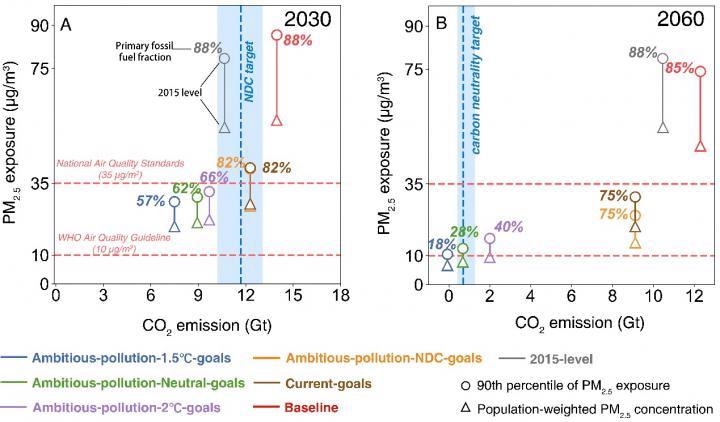May 24 2021
Over the past few years, the clean air policies of China have considerably decreased PM2.5 air pollution. But more than 99% of the Chinese population is still vulnerable to PM2.5 concentrations beyond the World Health Organization (WHO) Air Quality Guidelines of 10 μg/m3.

Image Credit: ©Science China Press.
Climate actions with the goal to decrease the consumption of fossil fuels have considerable air quality benefits. The declaration of aspiring climate commitment to realize carbon neutrality by 2060 might fuel the power to endured air quality enhancement in China.
Integrating Global or China’s climate mitigation pathways (that is, global 2°C- and 1.5°C-pathways, carbon neutrality goals, and NDC pledges) and local clean air policies, Chinese energy system, anthropogenic emissions, and PM2.5 air quality pathways from 2015 to 2060 are evaluated.
If the government enhances the source treatment by promoting the renewable energy fraction, pushing the production peaks of high consumption industries (such as cement, iron and steel), expediting the phasing out of scattered coal while still promoting the in-depth end-of-pipe control in highly polluting industries, diesel-fueled engines and vehicles and VOC-related industries, China would fulfill the NDC climate target in 2030 while also mitigating the national population-weighted PM2.5 concentrations to ~28 μg/m3, thereby realizing the national air quality standards.
But the advantages of end-of-pipe control reductions are predominantly exhausted by 2030, and decreasing PM2.5 exposure of most of the Chinese population to less than 10 μg/m3 by 2060 will possibly need more aspiring climate mitigation measures like China’s carbon neutrality goals and global 1.5 °C-pathways.
The solution, by 2060, will be for China to finish the conversion of low-carbon energy, with the dominant role of renewable energy (that is, the renewable energy power generation would make for over 70%, electricity and hydrogen vehicles would account for more than 60%, and the fraction of coal would be below 15% in industry sector).
Such a detailed energy transition would lower carbon emissions by 90% in China. Consequently, the average yearly exposure level of PM2.5 will be nearly 8 μg/m3, which is lower compared to the WHO guideline and the air pollution issue has been resolved basically.
Cheng et al. suggest that practical plans to tackle both air pollution and GHGs emissions in the near term, in which co-control efforts focusing on co-emitted sources (that is, fossil fuel consumption), co-management mechanism on O3 pollution and PM2.5, and co-development plan on low carbon economy and clean energy transition are emphasized.
Future clean air pathways in China must change from end-of-pipe control to energy and economic system optimization. At the same time, China must actively encourage the air quality standards to slowly combine with the appropriate WHO standards 10 μg/m3 as a new long-standing goal, to expedite the execution of carbon neutrality strategy.
Journal Reference:
Cheng, J., et al. (2021) Pathways of China’s PM2.5 air quality 2015–2060 in the context of carbon neutrality. National Science Review. doi.org/10.1093/nsr/nwab078.